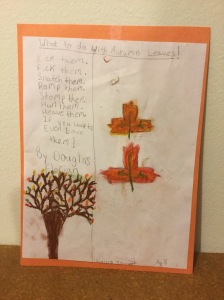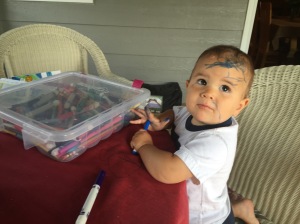This post is a week late. Obviously I don’t keep any sort of blog schedule-Ha! Since we started schooling again I haven’t written at all! But last week was our “Sabbath week.” We school 6 weeks on 1 week off. It is a beautiful time of rest and re-calibration. I spent a vast majority of the time freezer cooking, which was a great thing, but in my heart I knew that I needed to stop and asses how things were going before we continued. I didn’t and this week I regretted it. So a week late, I sit here reevaluating. (As this practice is so beneficial for me. If I didn’t write it here I would have to talk it all out with my husband. He does not enjoy the tweaking and evaluation process so he is thankful that I do a lot of it in written form.)
Read a-louds-I rocked the read a-louds first term. I picked stories that I knew I could read a-loud well; it is was so enjoyable. I started a book last week that wasn’t as easy to read out loud. I am going add it to our audio book list and find something else to read this week. I also used 5 in a Row with my kindergartner, but everyone sat in on that this as well. We enjoyed the stories together and practiced finding the different elements of a good story.
“I picked stories that I knew I could read a-loud well…”
Veritas History Online-This is still a great option for us. I think that my only complaint is that I wish it followed a 4 year history cycle. Sometimes I would like to supplement with other currics and would be easier to do if it followed a 4 year cycle! The kids’ test scores have improved this year. Test taking is a skill that they will need someday so it is good to know that they both understand the material and can take tests well.
Teaching Textbooks-There is a great deal of review at the beginning of the year. It turns out he needed it. 😉 I think that I will find some free printable worksheets for some additional review and confidence before moving forward. Mastery, understanding, and confidence is so important in math.
Math U See-My 2nd grader is plowing steadily ahead. I debated pushing him and seeing how fast he could go through this book and move on to the next. The more that I thought about I decided against it. The skills that he is working on is so foundational. Why rush it? I am assigning quite a bit of practice work, and he is not discouraged.
Build-Your-Own-4th-Grade Math-Before I started planning for the current school year I asked for his thoughts on math for our 4th grader. Somewhere along the line she got the idea that she hates math-not that she isn’t good at it, but just that she hates it. She began with MUS, then switched to Horizons. I wanted to switch her back to MUS for my own ease, but my husband reminded me of some of our math goals for our kids and encouraged me to put together a math specifically for her. It wasn’t the answer I wanted, but it was the right answer. We are using the MUS DVDs to teach the math concept, but different workbooks for a little more variety in practice. So far so good.
Spelling Workout-My first grade and forth grader really liked Spelling Workout last year. They were able to work independently, and I thought it was great for their vocabulary too.
God’s Design Science-The first term we “finished” up our book on plants. I resisted the urge to plow ahead in the text and took it outside to evaluate leaves and roots. It meant that we had to skip unit on unusual plants. It was the right decision. My oldest son has been itching to do more with science and approached me about it. What kind of homeschool mom would I be if I said, “No, you can’t learn more!”? We ordered him Exploring Creation with General Science with the MP3 audio companion. We are only one week into that one, but he has enjoyed his two days of “advanced” science.
Handwriting without Tears-Still my favorite. I will say it is amazing to see the differences in kids. One kid can have the most beautiful artistic handwriting and eagerly do page after page. Another kid can solve complicated math problems in his head and yet struggle to get two sentences written neatly on a page.
Free-Write Friday-I am so glad that before we started a formal writing curriculum we started with free writes. The kids really enjoy expressing whatever is on their minds without being bogged down with the mechanics. They each choose one of their Free-Writes to edit at the end of the term. I think that they enjoy that too.
Bravewriter’s Language Arts program, Arrow– The jury is still out for me on this. A Charlotte Mason approach to language arts sounds really good to me, but it is a leap of faith for me to put it into practice. Arrow takes a children’s book and spends 4 weeks on 4 different passages doing copy work, dictation, spelling and grammar practice. Since Arrow is organized in 4 week units and our term is 6 weeks, we used traditional grammar worksheets for the remaining 2 weeks. There is an ease in teaching to the worksheet. I have felt like the Abeka worksheets teach themselves. I am still figuring out how to teach the Arrow units.
IEW Writing-I don’t know if I am teaching this “right.” I went the economy route, and bought a really old version. I have the CD’s that teach me how to teach it, but I don’t have the CD’s for the kids. We are using the co-op schedule for All Things Fun and Fascinating. I really should have gone back and reviewed these CD’s last week for my own confidence in teaching. I also need to watch myself that I don’t become a “slave” to the curriculum and the schedule that it suggests. It is more important that the kids master each the writing skills that is presented than keeping the suggested schedule. (I am going to write that again to keep it in the forefront of my mind… “It is more important that the kids master each of the writing skills that is presented than keeping the suggested schedule.” There, hopefully that sticks!)
“It is more important that the kids master each of the writing skills that is presented than keeping the suggested schedule.”
All About Reading-If I have a homeschool regret in the last 7 years it would be NOT using this program from the beginning. We are taking this so slow. My kindergarten is only 5, and phonics do not come naturally to her. Because of this I would rather wait another year to work on reading, but she so badly wants to learn to read. Her attitude is really great so we are working together, making strides toward her development as a reader. (Quirky commentary about this girl. She picks out a chapter book from the library every time. Then throughout the week she will sit down to read it-always with a bookmark. She will sit for a period of time carefully “reading” each page and then mark her spot so that she can come back and continue “reading” the next day. I wish I knew what was going through her head as she looks at page after page of words that she does not yet know how to decode!)
Sequential Spelling-My dyslexic son is using this. We both like it for his situation. He is reading well now and did NOT want to continue to use Barton, his Orton-Gillingham curriculum. All About Spelling was confusing because it used a lot of the Orton-Gillingham method, but called the rules by different names. This program does a good job of showing the patterns in words and builds gently in difficulty. He is doing well within the spelling program itself. I am hoping to see it cross over into his other writings.
First Language Lessons 2- My original plan had been to do the oral portion of these lessons all together in Morning Time, geared toward my 2nd grader but as a great review for my older two. That worked swimmingly the first 5 weeks; then co-op started and two days a week different kids leave at 8:30 in the morning and Morning Time suffered a hard blow. That leads me to my next conundrum…
Morning Time– Our Morning Time in August were great for the most part. HSAP has thrown a huge monkey wrench into it. Two or 3 days a week kids are coming and going for enrichment classes and/or field trips. For Morning Time this term we had planned to continue reading Who is God? And Can I really Trust Him?, Aesop’s Fables and replace our science reading with geography. Our memory work would be a new Bible passage, poem, hymns and creed as well as begin working memorizing the state and capitals. Because I was apparently very optimistic I thought we’d try to throw some Latin in there as well. (“Optimistic” or “senseless” pick your adjective.) It is clear now that I need to rethink all this.
I need to have a full Morning Time option and an abbreviated Morning Time for days that we need to be out the door by 8:20 with lunches in hand. So that is what I am working on the rest of the day. What are the few things that bless us and need to be done, even in a time crunch and how can we loop the other subjects in a way that is fun and engaging?
What a great first term we had! I really enjoyed looking back and seeing what really worked and needs to keep going and what needs to be tweaked as we move forward. Time to go get ready for the next week!











